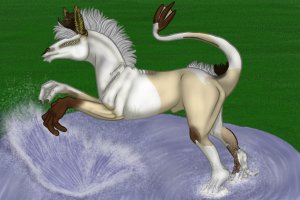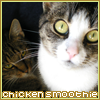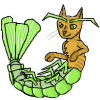Sketch of a Neravontii!
Species originally created by MustangKnight and now owned by me as of the past 4 years.
Can't believe it's already been 4 years!
I've got some plans!
This is a Closed Species, created by and originally owned by Mustangknight, then sold to me at the end of 2020!
This will be a new line base for the adopts while temporarily running on CS.
Things will be slightly different than when originally ran on here vs the private discord changes.
Breeding may not open for some time, noting that out now!
If a staff/admin sees this, you can move it to closed species!
This species will never be for sale!
No CO-Ownerships will be considered!!
If i die young, or unable to ever run closed species again, Neravontii & Tephlans would go back to Mustangknight!
Forum rules
Reminder: Copying another person's art without permission to reproduce their work is a form of art-theft!
Click here to see the full Art Rules!
Reminder: Copying another person's art without permission to reproduce their work is a form of art-theft!
Click here to see the full Art Rules!
Neravontii Agency Base (V4) by KathrynKat
| Artist | KathrynKat [gallery] |
| Time spent | 18 hours, 51 minutes |
| Drawing sessions | 20 |
| 13 people like this | Log in to vote for this drawing |
14 posts
• Page 1 of 2 • 1, 2
Neravontii Agency Base (V4)
Last edited by KathrynKat on Sat Mar 15, 2025 2:48 am, edited 13 times in total.
I was WildHorse32 Years ago & is my DA Username
Click here to find all of my personal
archives/harems n such for personal OCs and closed species!

Free-To-Use Art | Art + Past Art + Adoptables+
Click here to find all of my personal
archives/harems n such for personal OCs and closed species!

Free-To-Use Art | Art + Past Art + Adoptables+
-

KathrynKat - Posts: 29214
- Joined: Tue Aug 30, 2011 6:15 pm
- My pets
- My items
- My wishlist
- My gallery
- My scenes
- My dressups
- Trade with me
Rules & Important Notes
Rules & Important Notes:
Lore:
Originated & Where To Find:
- - For the time, no tickets can be redeemed.
- For the time, it is impossible to receive a full Deravontii. They're currently unavailable.
- Ridgeback on CS for the time, will remain under 50% Deravontii.
- Breeding will not be open for a long time, and will be focused on adopts.
- Each user is allowed to own as many Neravontii as desired.
- MYOs will only be available to artists at the time.
- Customs will not be open for awhile, and will not be obtainable with tickets at this time.
- You're more than welcome to trade your Neravontii. You may trade them for other species, C$, CS pets/items, art and other things within the species. For the time selling a Neravontii of V4, for cash or currency outside CS is forbidden.
- I own Tephlans every sub-species of Neravontii/Deravontii. The rest of Vashta and other species of Vashta, are owned by ElizaChikatta.
-
-
Lore:
Originated & Where To Find:
- - Neravontiis were first discovered on the planet Vashta, and that they Originated on Vashta. However, they have repopulated on other planets. Unintentionally, the Neravontii have repopulated in the wild of Earth itself. Only in small Percentages, have Ridgebacks been encountered and fairly impossible to come across any Deravontii on Earth, except for in captivity.
- Over the years, these large beasts sometimes break free after they've transported. Over the years, some have repopulated on Earth, and grow massively. Neravontiis are very difficult to capture and harder to tame than most wild animals.
- It's common that even a captured Neravontii may be found in the wild and in the mix of a wild herd or a loner straying and surviving off prey like deer and smaller creatures.
- Neravontiis at the Agency's Adoption Center, were rescued, surrendered, being auctioned or captured.
Last edited by KathrynKat on Thu Jan 16, 2025 2:29 pm, edited 15 times in total.
-

KathrynKat - Posts: 29214
- Joined: Tue Aug 30, 2011 6:15 pm
- My pets
- My items
- My wishlist
- My gallery
- My scenes
- My dressups
- Trade with me
Neravontii Lore

Anatomy:
The neravontiis skin is like that of a persons but with a layer of extremely fine, dense hair. Neravontii have slim equine like heads but are lacking eyes as evolution deemed them unnecessary. Although the eyes aren't present neravontii have excellent "vision", and are fully aware of their surroundings thanks to heat sensors pits located just above the nostrils along with the fur like sensors in their ears. These sensors are highly sensitive and can detect shifts in the environment to help find prey and sense other predators. Neravontii are very wary of touching their sensor tufts as they don't grow back and can weld them visionless!
Neravontii have 7 airways total. The nostrils can be used, like a humans, for breathing and smell. Neravontii also have two large airways, one on each side of their chest for breathing with smaller airways just above in front of their shoulders. These holes can be closed when not in use to prevent foreign materials from entering their airways. Neravontii have two retractable k9s on their upper part of the mouth, used for hunting and defense. Because of their lacking fur, the Neravontii use the space on their head where the eyes would be located to collect and regulate heat throughout the neras body. In cold climates Neravontii could freeze to death if the space is covered for an extended period of time. Neravontii have very similar hands to people, the difference is the strength. A neravontiis hands are very powerful to allow them the easily climb trees and other structures. Their feet are similar to primates, and on the ends of their tail there are, normally, three 'fingers' that allows them to grip and hold things. Neravontii have long thin bodies for running at high speeds, which top out at around 60mph. Adult Neravontiis range can be found in a chart lower in this channel
Foals
When a baby neravontii, known as a foal, is born they are around 120 centimeters tall the biggest foal being marked at 129 centimeters. Female neravontii usually give birth to one foal but twins and triplets have also been documented. Within the first hours foals struggle to stand and are extremely wobbly, they don't fully know how their hands and feet work and can be quite comical to watch. Foals walk on the bases of their hands and feet until around 2 weeks of age. Around the 2 weeks they will begin learning how stand using the ends of their fingers after they have mastered, or think they have, they start to run and mock hunt with their parents and fellow herd members. At one month they are fully grown and can reproduce!
Eating Habits
Neravontii prey on small animals and birds. But can easily hunt in small packs to take down larger animals such as dogs, housecats, deer, and even horses and other livestock. When food is really running low they have also been seen eating insects and vegetation, and wont hesitate attacking people nearby. Vegetation such as moss, leaves and branch limbs are foraged for regularly and sick Neravontii are noted to be seen eating large amounts of moss to help easy a hurting belly.
Vocalization
Neravontii have a wide range of vocalizations that they like to use. The most popular being the death curdling screams to signify that they are around, this is similar to a higher pitched horse neigh or a human child. An agitated Neravontii can show their displeasure by slow, deep grumbling growling noise with the occasionally distress snort. Out in the wild its been observed that Neravontii signal to others that they are near by fast loud whooping noises, that would be similar to the noise of a zebra. They also do this while on hunts to tactically take down a large prey animal.
Habitat
Neravontii have been found in all types of climates. From hot climates to cold climates they do well in almost any, although certain types don't far well in certain climates. For example racing type neravontii have a harder time in colder climates because of there thin frame. Although racing type neravontii can survive in colder climates with help from people you wont find wild race types where it snows.
Last edited by KathrynKat on Thu Jan 16, 2025 11:41 am, edited 3 times in total.
-

KathrynKat - Posts: 29214
- Joined: Tue Aug 30, 2011 6:15 pm
- My pets
- My items
- My wishlist
- My gallery
- My scenes
- My dressups
- Trade with me
Neravontiis, Ridgeback Neravontiis and Racer Neravontiis
This stuff is a large WIP
-

KathrynKat - Posts: 29214
- Joined: Tue Aug 30, 2011 6:15 pm
- My pets
- My items
- My wishlist
- My gallery
- My scenes
- My dressups
- Trade with me
-

KathrynKat - Posts: 29214
- Joined: Tue Aug 30, 2011 6:15 pm
- My pets
- My items
- My wishlist
- My gallery
- My scenes
- My dressups
- Trade with me
Re: Neravontii Agency Base (V4)
Taking a few day break. I plan to tackle more again starting late Monday or Tuesday!
I can't wait to get everything needed done before I split the covers. My plan is to have the 3 types split up for adoption covers due to how many folders there'll be.
Still got some stuff undercover that aren't 100% officialized until posted here. Tho some stuff here might be edited except original lore!!
Currently gave Western saddle, breast belt, girth and pads done. Qhile the Ebglish I've only started on the saddle base.
I plan to also make a race tack. Not starred on any of the halters bridles or reins.
Western set took somewhere around 2 hours of work.. so round that up for each set. It could take me days to weeks more. Have 1 commission project to give more hours to and couple other species. Reason idk when I'll open.
I'm open to suggestions for the mascot.
Would people like to see my first original ZeKorra take place as the V4 or something fresh?
I can't wait to get everything needed done before I split the covers. My plan is to have the 3 types split up for adoption covers due to how many folders there'll be.
Still got some stuff undercover that aren't 100% officialized until posted here. Tho some stuff here might be edited except original lore!!
Currently gave Western saddle, breast belt, girth and pads done. Qhile the Ebglish I've only started on the saddle base.
I plan to also make a race tack. Not starred on any of the halters bridles or reins.
Western set took somewhere around 2 hours of work.. so round that up for each set. It could take me days to weeks more. Have 1 commission project to give more hours to and couple other species. Reason idk when I'll open.
I'm open to suggestions for the mascot.
Would people like to see my first original ZeKorra take place as the V4 or something fresh?
I was WildHorse32 Years ago & is my DA Username
Click here to find all of my personal
archives/harems n such for personal OCs and closed species!

Free-To-Use Art | Art + Past Art + Adoptables+
Click here to find all of my personal
archives/harems n such for personal OCs and closed species!

Free-To-Use Art | Art + Past Art + Adoptables+
-

KathrynKat - Posts: 29214
- Joined: Tue Aug 30, 2011 6:15 pm
- My pets
- My items
- My wishlist
- My gallery
- My scenes
- My dressups
- Trade with me
Re: Neravontii Agency Base (V4)
I love the new lines, it looks really lovely <3
I would possibly go with something fresh, so it's a completely new start?
But I'm happy with whatever you choose to do, I look forward to hopefully adopting something
I would possibly go with something fresh, so it's a completely new start?
But I'm happy with whatever you choose to do, I look forward to hopefully adopting something
-

Ruby-Skylark - Posts: 8011
- Joined: Mon Mar 16, 2009 12:50 am
- My pets
- My items
- My wishlist
- My gallery
- My scenes
- My dressups
- Trade with me
Re: Neravontii Agency Base (V4)
These look great

-

Spiritstar3 - Posts: 138933
- Joined: Thu Apr 19, 2012 11:56 am
- My pets
- My items
- My wishlist
- My gallery
- My scenes
- My dressups
- Trade with me
Re: Neravontii Agency Base (V4)
I'd go for a fresh Mascot too - maybe one with simple markings so that they're easier for people of all art levels to draw for events and such? ^0^
Edit: HI RUBY!
Edit: HI RUBY!
-

Rondell - Posts: 2343
- Joined: Fri Oct 10, 2008 9:22 am
- My pets
- My items
- My wishlist
- My gallery
- My scenes
- My dressups
- Trade with me
Re: Neravontii Agency Base (V4)
Rondell wrote:I'd go for a fresh Mascot too - maybe one with simple markings so that they're easier for people of all art levels to draw for events and such? ^0^
Edit: HI RUBY!
*waves* Hi Rondell
-

Ruby-Skylark - Posts: 8011
- Joined: Mon Mar 16, 2009 12:50 am
- My pets
- My items
- My wishlist
- My gallery
- My scenes
- My dressups
- Trade with me
14 posts
• Page 1 of 2 • 1, 2
Who is online
Users browsing this forum: wildfur2202 and 10 guests


